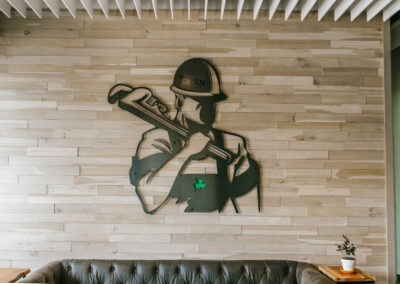Wet pipe fire sprinklers have a long history of success, however there are some applications where the introduction of water is as harmful (or more so) than the fire itself. Regardless of whether the system was discharged legitimately, accidentally or by inadvertent damage, water can pose a threat to a number of occupancies. Water flow, that was designed to protect occupants and property, is now a source of property loss, potential income loss, insurance premium increases or loss of coverage, and a general interruption to business.
There are alternatives to traditional fire sprinkler systems and each should be evaluated against the application, including the occupancy type and use and the cost associated with loss or disruption. Typical applications include:
- Electronics rooms/facilities – introducing water to a room filled with vital electronics or computer equipment could bring a business to its knees.
- Museum & library fire protection – fire is not the only threat to the irreplaceable items found in the thousands of cultural centers across the country. Water or chemical damage can add up to millions of dollars in restoration costs or result in the total destruction of priceless treasures.
- Hospitals & medical centers – Sensitive equipment like MRI and x-ray equipment could be rendered useless by the introduction of water, causing undue harm to patients awaiting care.
When a particular occupancy requires a higher degree of protection against property loss it makes sense to evaluate alternative fire suppression systems. There are two primary choices to consider for these applications. First is a pre-action system, which is based on a traditional dry pipe system. The second is a gas system, which eliminates water from the equation altogether.
Pre-Action Systems
Pre-action fire sprinkler systems employ the basic concept of a dry pipe system in that water is not normally contained within the pipes. The difference, however, is that water is held from the piping by an electrically operated valve, known as a pre-action valve. Valve operation is controlled by a combination of independent heat and smoke detection. Two separate events must happen to initiate sprinkler discharge. First, the detection system must identify smoke. Secondly, to fully engage the system it must identify heat. The combination of the two will discharge the system. Because the system requires two safeguards before sending water to the sprinklers, it is particularly effective at reducing damage due to accidental discharge.
Gaseous Systems
The second type of system suitable for water-sensitive areas is a gaseous system. These systems use an inert gas to displace oxygen. Once the oxygen is removed from the environment, the fire cannot burn. Gaseous systems are suitable only for protecting the contents of a tightly sealed room that can contain the gas once it is discharged. Any breach to the room like an open door or window, operating ventilation system, wall/floor openings around pipes or conduit, etc., will permit the gas to escape and void its usefulness in extinguishing the fire.
Therefore safeguards need to be installed to ensure the room can be sealed upon discharge of the system. Dampers on ducts, closures on doors and other room-sealing precautions need to be installed and integrated into the system to ensure no gas escapes.
Gaseous agents provide the following benefits:
- Safe for people
- Does not leave a residue
- Electrically non-conductive and non-corrosive
- Eliminates water damage
Both systems come with a unique set of pros and cons and need to be evaluated against budget, the type occupancy and, ultimately, the cost of potential water damage. Once these and other factors are considered building managers and facilities managers are better equipped to make a decision. Whether for a new facility or a change out of an existing system, Ryan Fireprotection can provide the expertise to protect lives while protecting valuable property from fire and water damage loss.
